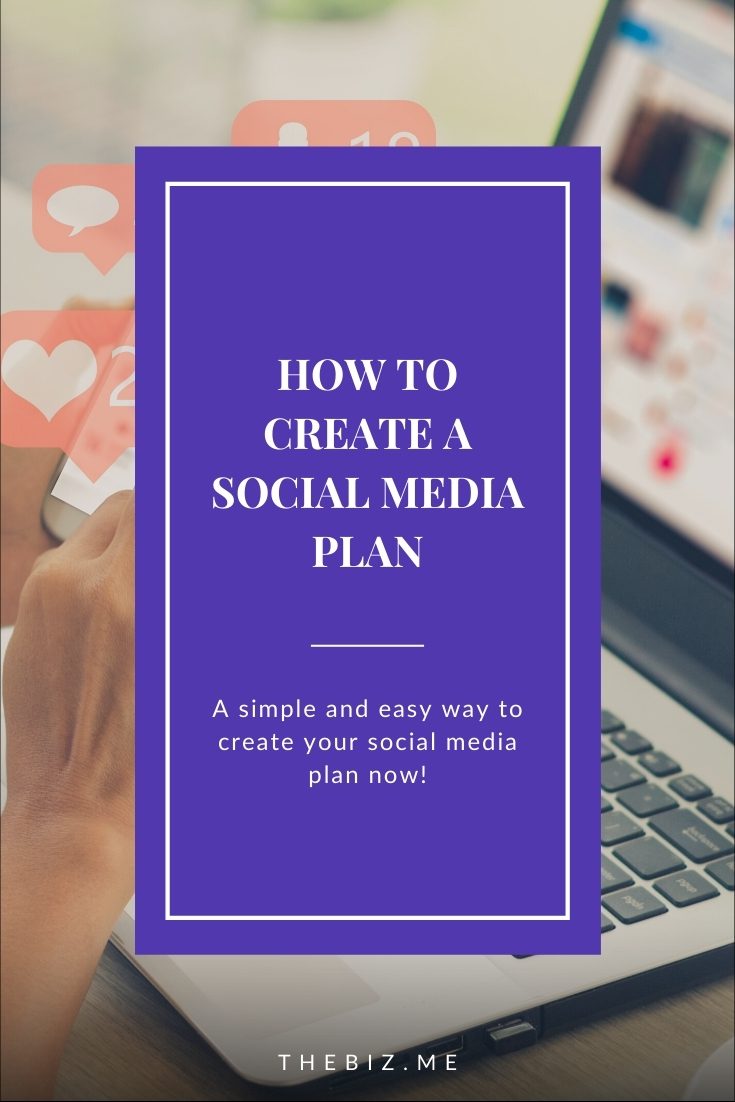
If you’re a small business owner, chances are you’re not a professional social media marketer, too. You’re probably familiar with most social media platforms but you might not know how to use them all effectively for your business.
You probably know that you should be on social media, given the fact that 3.5 billion people worldwide use at least one social media platform. In the United States, 72% have at least one social media account, which is so crazy to think about! But, just knowing how important it is for a business to be on social media isn’t enough. You have to know how to use it to your advantage!
When it comes to running a business account, social media gets a little more complex. The rules, the algorithms, the audience, the content… it’s a lot to consider and on top of that, everything varies from one platform to another.
Understanding social media can be overwhelming for many business owners who are just trying to develop a simple marketing plan that they can put into action quickly.
Even though it takes a little work up front, a social media plan is critical for your business. It’s going to help you take advantage of the free tools that social media offers so you can get your business noticed by new people. You can’t just create random posts and expect to see results. You need a plan that outlines specific goals and steps that show you how you’re going to get there.
But, before we get ahead of ourselves, let’s talk about what a social media marketing plan is and how it can help you.

Keep reading to find out:
What Is a Social Media Plan?
A social media plan is a marketing plan that includes every goal and every action you want to take on social media. It might also map out all of the social media content you want to create and post.
Basically, it’s a way for you to have more clarity so you can work in batches, see what’s coming up and what needs to be done, and measure the success of your efforts when it comes to social media.
What Should a Social Media Plan Include?
You can tailor your social media marketing plan according to your own needs. However, there are a few aspects that you should definitely include in your strategy:
- Current Strategy Analysis
- Brand Persona
- Audience
- Goals
- Competitors
- Social Media Content Calendar
- Overall Analysis
As you will see, creating a successful social media marketing plan goes beyond just an editorial calendar.
It will take a little time for you to put it all together at first but just keep in mind, you only have to do it once. After you have everything set up, you can use your social media plan on any platform you want to start using for your business.
How to Create a Social Media Plan for Your Small Business in 8 Steps
Most social media guides out there seem to be made for big companies. We wanted to create a simple guide for small businesses that contains everything you need to create your own social media marketing plan. Here are the eight steps that you can follow right now to build out a social media marketing plan from scratch:
1. Analyze Your Current Strategy
Most of you are probably not starting from square one. Chances are you’re not an absolute beginner on social media, and you might already have an account for your business on a few social channels. If so, just use the information you already have to analyze what’s working and what’s not.
If you don’t have an account set up for your business yet, go ahead and skip to step two. However, if you regularly share business-related stuff on your personal social media accounts, keep on reading through step one.
If you’ve ever posted images, posts, or videos related to your business, you can look back and see what kind of engagement you got from it. Did people like the post? Did they watch the video? If you do have a business account, have people clicked on your call to action button or sent messages to you?
These are great starting points because no matter the results, you have some data to work with. Even if everything has fallen flat so far, you know what hasn’t worked. That is still valuable information!
How to Analyze Your Current Strategy
So, before you move to the second step, take some time to evaluate the plan you already have in place. Here’s what you’re going to do:
List All Social Networks Your Business Is Already On
This is simple; just create a list of the social networks you’ve posted on for your business. You can list the social channels you have a personal account on if you’ve been posting business-related content on it, too.
Is Your Audience On These Social Channels?
Sometimes, the reason why you can’t grow on a particular social media platform is simply because your target audience doesn’t hang out there.
For each of the main social media channels (Facebook, Twitter, Instagram, YouTube, etc) check the demographics and see if they align with your ideal audience.
If you’re not certain who is your ideal audience, you’ll work on that more in step three, so you can always come back to this step afterward.
For example, is the work you do really visual, and does it appeal to a younger audience? If so, Instagram might be a great place for you to share some social content. If you attract a slightly older audience, then Facebook might be the best place to focus your marketing efforts. Do some research and answer this question: are the people I want to interact more with on these social networks?
Are You Posting Enough? Is Your Social Content High-Quality?
Another question you might want to ask is whether or not you have enough time to post regularly on social media. If you don’t have enough time to post or create high-quality content, you might want to rethink your strategy.
Remember, it’s better to not have an account on every social media platform if you can’t dedicate some time to managing it, posting content, replying to messages, etc. Start with one platform if time is limited, then add more later. You want to show up in a professional way and create a positive experience first and foremost.
Are You Getting Any Results?
If your audience is on the social media channel you’re on and you’re posting quality content, you’re probably getting some results. However, you can’t expect to see incredible results overnight. If you’re a new business or simply new to social media, it might take some time for you to get real results.
Before you get discouraged, look at what has happened. Did you make any sales through social media? Did you get hired for a gig? Did you notice more people are talking about you or engaging with your brand?
List these results and try to look at what you’re doing to see what’s creating these results and then figure out how you can do more of the same things but in new and different ways. Then, I want you to look at the posts that weren’t too successful and write down why you think people didn’t interact with them as much.
This is a great way to measure the results you’re getting so you can really dial in your marketing with social media. It can also help you determine whether you’re on the right platform or if you need to pivot to another social platform that might get you better results.

Should You Abandon Any of These Social Media Channels?
If you’ve determined that you’re not getting great results or your audience is on a different platform, you might decide to abandon a social media channel altogether. Sometimes, it’s just time to move on! You don’t need to be spending precious time and energy on something that’s not going to bring you any kind of results.
Maybe you decide you don’t want to abandon a social media channel entirely. Maybe you just want to post less often and try out a different platform instead. Keep in mind, sometimes we overlook “less popular” social media platforms that might actually be perfect for our brand. You never know unless you try it!
So, if you feel like you’re doing too much and not getting enough back in return, why not pivot and try something else for a while?

2. Find Your Voice: Create a Brand Persona
A brand persona is a way to see your business as a person with personality traits, values, and attitudes. In marketing, we create brand personas to be consistent, authentic and connect with our ideal customers.
If you have a personal brand, your brand persona is going to be an extension of yourself. But, if you have a small business that isn’t using your own name and likeness, you’ll need to figure out what your brand persona is going to be.
Keep in mind, people connect with other people. The idea behind a brand persona is to look and act more like a person so people can connect to it. Another way to look at it? A brand persona creates a reliable and realistic representation of your ideal audience so they feel more drawn to it.
Here’s how you can create your brand persona:
- What are your brand’s values? (e.g., honesty, vulnerability, boldness, passion, accountability, etc.)
- Who do you want to represent for your audience? (e.g., an expert, advisor, friend, etc.)
- What some adjectives to describe your brand? (e.g., young, friendly, caring, supportive, elegant, etc.)
- What words do NOT describe your brand’s personality? (e.g., rude, outgoing, shy, extravagant, etc.)
- How would you like to speak to your audience? (write down a few sentences based on what you’ve defined about your brand values, traits, etc.)
Once you’re done, you have an outline of your brand persona. Document it and refer to it often as you create your social content. Whenever you feel like you’re getting lost, you can go back to it and get a clear vision of who you want to be and how you want to serve.
3. Know Your Audience: Create Buyer Personas
I know it sounds like there are a lot of personas in this social media plan, but creating buyer personas is a very important step when it comes to marketing for social media and marketing as a whole.
With our brand persona, we have given our brand a voice. However, we also need to hear our ideal customers’ voices.
While you have probably already defined your ideal customer, creating buyer personas is a whole other level and will make your marketing strategy so much easier.
So how do you do it? A buyer persona is like a semi-fictional character. Many business owners will simply use real-life customers and individuals that they already know to create a persona. This makes it so much easier to define their goals, needs, problems, behaviors, motivations, etc.
When you understand your audience better, you can create the best content for them. This will help them relate to your brand more because they will feel like this content was created especially for them.
Try to create at least two different buyer personas for your business. If you already have a decent following on social media, you might want to create a poll and ask for some data so you can be more precise with your buyer personas. Or, you can simply ask people you know to answer a few questions on a form (you can easily create one on Google Forms).
If you don’t yet have buyers, think about the kind of people you could see becoming your customers and build out your buyer persona that way.
Here’s what your profile should include:
- Name (it can be a fictional name)
- Age
- Income (just estimate this based on what you know)
- Location (city, country, etc.)
- Story (briefly describe this person’s story, like their background, education, work, family, etc.)
- Problems (describe the problems this person has that could be solved by your service or product)
- Ambition (describe what this person wants to achieve after using your service or product)
- Favorite social media channels (which social media channels this person currently uses)

4. Define Your Goals and Objectives
Goal setting is another fundamental step to set up a successful social media plan. As I’ve said before, no marketing strategy is complete without goals. Without clear goals, you don’t know where you’re heading, and it becomes harder and harder to create content that gets you real results.
When you don’t have goals, you create content randomly and there’s no real schedule or priority to the posts. Setting goals and objectives will make it easier for you to measure your success and understand what needs to be improved.
Ready to get started?
Defining Your Social Media Goals
This is exactly what it sounds like. You need to write down some of the results you hope to achieve as a result of your social media marketing strategy. If you feel stuck, here is a list of goals you can pull from if you need to:
- Increase brand awareness
- Get more leads
- Drive more sales
- Increase Engagement
- Improve customer acquisition
- Enhance customer service quality
- Increase traffic
- Establish authority in your niche
- Increase authentic engagement
These aren’t the only ones, but they are some of the most common goals and probably ones that you’ll use in the beginning as well.
Defining Your Objectives
For each goal, you should create at least two objectives. The objectives must be measurable. In other words, they should include numbers that you can look at to see whether you’ve achieved your goal. They should also be time-bound, meaning that you should establish a time frame to get to those results.
Objectives can be anything like:
- Followers
- Impressions
- Likes
- Saves
- Comments
- Messages
- Shares
- Clicks
- Leads generated
- Increase in sales
- Testimonials
- Customer satisfaction score
- Reviews
Depending on how many social channels you’re on, you may want to create some specific objectives for each of them.
A Practical Example
So, let’s say your goal is to increase brand awareness and you have business accounts on Pinterest and Facebook. Your objectives could be something like:
1. Get 10,000 impressions per month in the first quarter;
2. Get 100 followers in the first quarter;
3. Get 300 saves in the first quarter;
4. Get 400 link clicks in the first quarter;
1. Get 400 new Facebook users to “like” my business page in the first quarter;
2. Get 20 likes per post on every social post during the first quarter;
3. Increase my website’s traffic by 10% with users coming from Facebook in the first quarter;
With clear goals and objectives, you’re much more likely to have a successful social media plan. You can focus on creating the right content to the right people and you can measure and adjust as needed at any time!

5. Look at Your Competitors
If your competitors have been on social media for a while, it might be a little discouraging, especially if you’re just starting out. It’s normal to compare, but don’t let it trick you into thinking that you’re not good, experienced, hardworking, or successful enough.
Instead, look at your competitors as a way to be inspired and learn about their strengths. What about their work on social media is completely awesome? Take some time and write down everything you admire about each one of your competitors. When you do that, you can think of ways to implement what you like about their work on your business.
Maybe they have amazing photos of their products and services, a curated feed, or they’re posting really helpful content that’s getting a lot of likes. If it’s working for them, why not add it to your social media plan and see if it works for you, too? I’m not saying you should copy your competitors. Do things your own way, but learn from what they are doing.
While you’re looking at their feeds and seeing what’s working, look at what they might be missing, too. Again, you don’t need to compare your business to theirs. The point here is to look for things you think they could be doing better in order to serve their people. These things can get added into your plan and you can use these ideas to set yourself apart from your competitors!
6. Choose Your Social Media Networks
I know in step one we talked about the social media channels you’re already on, but now is the time to really zero in on the channels that your business should be posting to on a regular basis.
Think about each social network, the audience, and the purpose of the platform. For example, you know that Facebook has a broad audience, but it’s not as popular among Millennials and teenagers. Instagram, on the other hand, is more popular among Millennials. LinkedIn is more formal since it’s a professional network, but it’s an amazing place to post long-form text and articles.
Consider each social networks’ strengths, weaknesses, audience, and capabilities to decide which one(s) you’re going to show up on, at least initially. Really think about whether you’re going to have time to create quality content and manage them.
If you don’t have enough time for multiple channels, make sure you choose the social network that attracts more of your target audience and supports the kind of content you want to create. For example, if you don’t have time to film and edit videos, don’t choose YouTube as your main social network. You might want to choose something like Facebook instead.
7. Set Up Your Accounts
Some small businesses are so eager to create their social media accounts that they forget how much the little details matter. I’ve seen so many pages with nothing more than the name and a few pictures on them. You have to put some effort into creating an optimized profile in order to be seen as professional on social media.
So, create and set up your account, then fill in all the information they ask you for. Create an easy to remember username and write a compelling biography. Use all of the resources they give you!
Add your email address, website, phone number, add a button with a call to action so people can reach you, start shopping, or book an appointment. Tell people exactly what you do and how you help improve people’s lives. Show them samples of your work, share your services, prices, and whatever else makes sense. Make it easy for people to say “yes” to you!
If the social media channel offer a specific business account option, take it. These types of accounts usually come with additional resources that you can use to analyze your audience, the performance of your posts, and so on.

8. Create a Social Media Content Calendar
Creating a social media content calendar is just one part of your social media marketing plan, but it’s a really big part People often mistakenly think that an editorial calendar is that same thing at the social media plan when really it’s just the last step of the plan.
You’ve already decided which social media channels to use, but you still need to determine what content works best on each platform, what you’re going to post, and how often. These are very important questions to think about as you build your perfect social media calendar and we’ll go through them one by one now:
Choose What’s Best for Each Platform
As I’ve said before, each platform is optimized for different kinds of content. On LinkedIn, users like to read longer posts. On TikTok, users stream funny, goofy, or interesting short videos without much informative content. Instagram is extremely visual but you can find some informative content mixed in, too. Facebook is the perfect social network to share videos and blog posts. Pinterest also (surprisingly) gives videos more exposure and helps to drive traffic to your website.
These are just a few examples of platforms and the content that is ideal for each of them. Don’t let this limit you, though. Other types of content might also work well, so do some research and make a list of the kind of content you need to create for the platforms you’re on.
Choose Topics
Next, you’re going to think about the various categories of content you’re going to create and share. You are a business within a niche, so your categories will probably align with that, but it is still nice to establish some general topics so you can have a clear picture of what you’re going to post.
So, let’s say you’re a restaurant. You might post about your own food, recipes, curiosities, nutrition facts, customer reviews, behind the scenes, your team, etc.
These are just some general examples. You can go even deeper as you look at your own business niche and your audience. Don’t just think about your business, think about your audience and their needs as well.
Use your content to help people solve their problems and educate them. Post updates about your business and the people who help you run it. Inspire your followers and establish a relationship of trust. Make sure you think outside the box and come up with several categories you can use as you come up with a plan for your content across your various social accounts.

How Often to Post and When
In addition to listing out the types of content and the topics you’ll post about, your social media strategy should also include the frequency of your posts as well as the days and times you want to stream things.
Again, each platform is different, so your plan should take that into account. Look at your analytics and see which times each social media channel recommends for you to post and follow their advice.
If you’re just starting, you probably won’t have enough information to pull from but after a week or two, you can take another look and see which times got you the best results.
As far as frequency goes, you will want to take into account the general recommendation but also consider how often you can reasonably create content. For example, Facebook recommends that you post 8 to 15 times per week, Instagram recommends at least 5 times per week and Pinterest around 50 to 70 times per week. That’s great if you can do it, but if you’re too busy, come up with something that will work for you and not add stress to your life.
Above all else, your focus should just be on posting high-quality content. You shouldn’t post something just for the sake of posting. Remember that people value and engage with good content, so that should be your main goal.
Need help creating a content calendar? Take a look at this post and learn how to create a content calendar for your small business.
Did you like these tips?! Then don’t forget to save the image below in your “Social Media Marketing Tips” board on Pinterest! Also, check out our Pinterest page and follow us to get daily updates + digital marketing and social media tips for small businesses!

We can’t wait to see what you do. Please tag us using the hashtag #GrowingMyBiz so we can see and share your work!